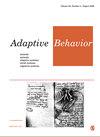控制机制:解释生物有机体的整合和多功能性
IF 1.3
4区 计算机科学
Q4 COMPUTER SCIENCE, ARTIFICIAL INTELLIGENCE
引用次数: 10
摘要
生物体作为整体来维持自身。每个单独的动作都可以通过表征执行该动作的机制来解释。但仅凭这些并不能解释各种活动是如何协调和普遍执行的。我们认为,这取决于一种特定类型的机制,一种控制机制。我们通过研究大肠杆菌中几种广泛研究的控制机制,对控制进行了阐述。根据我们的分析,控制机制与其他机制的区别在于,它依赖于测量一个或多个变量,这导致在控制机制中设置约束,从而决定其对其他机制中灵活约束的作用。在最基本的布置中,测量过程直接决定控制机构的动作,但在更复杂的布置中信号在测量和效应器之间起中介作用。这开启了对同一测量的多个响应以及基于多个测量的响应的可能性。它还允许串扰,从而形成控制机制的网络。这种网络整合了生物体的行为,但也对调整对特定测量的反应提出了挑战。我们讨论了综合活动如何仍然能够产生不同的、多方面的反应。本文章由计算机程序翻译,如有差异,请以英文原文为准。
Control mechanisms: Explaining the integration and versatility of biological organisms
Living organisms act as integrated wholes to maintain themselves. Individual actions can each be explained by characterizing the mechanisms that perform the activity. But these alone do not explain how various activities are coordinated and performed versatilely. We argue that this depends on a specific type of mechanism, a control mechanism. We develop an account of control by examining several extensively studied control mechanisms operative in the bacterium E. coli. On our analysis, what distinguishes a control mechanism from other mechanisms is that it relies on measuring one or more variables, which results in setting constraints in the control mechanism that determine its action on flexible constraints in other mechanisms. In the most basic arrangement, the measurement process directly determines the action of the control mechanism, but in more complex arrangements signals mediate between measurements and effectors. This opens the possibility of multiple responses to the same measurement and responses based on multiple measurements. It also allows crosstalk, resulting in networks of control mechanisms. Such networks integrate the behaviors of the organism but also present a challenge in tailoring responses to particular measurements. We discuss how integrated activity can still result in differential, versatile, responses.
求助全文
通过发布文献求助,成功后即可免费获取论文全文。
去求助
来源期刊

Adaptive Behavior
工程技术-计算机:人工智能
CiteScore
4.30
自引率
18.80%
发文量
34
审稿时长
>12 weeks
期刊介绍:
_Adaptive Behavior_ publishes articles on adaptive behaviour in living organisms and autonomous artificial systems. The official journal of the _International Society of Adaptive Behavior_, _Adaptive Behavior_, addresses topics such as perception and motor control, embodied cognition, learning and evolution, neural mechanisms, artificial intelligence, behavioral sequences, motivation and emotion, characterization of environments, decision making, collective and social behavior, navigation, foraging, communication and signalling.
Print ISSN: 1059-7123
 求助内容:
求助内容: 应助结果提醒方式:
应助结果提醒方式:


